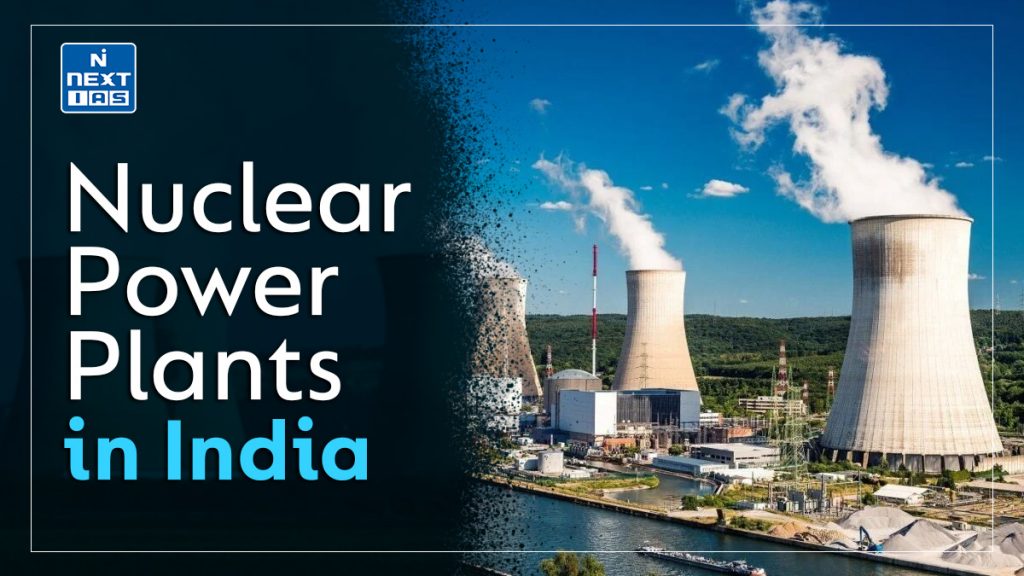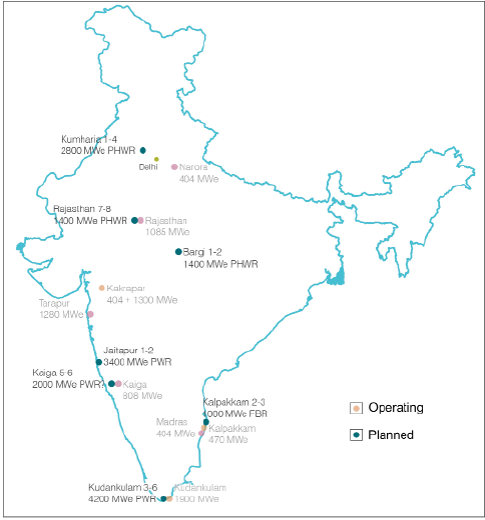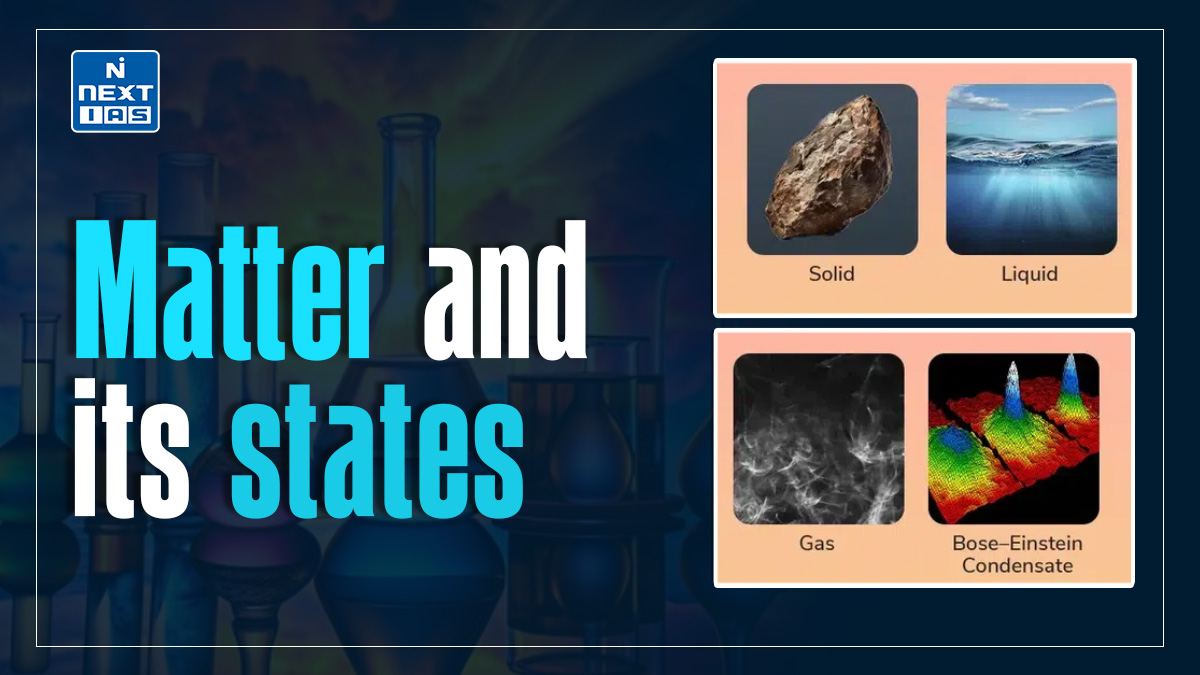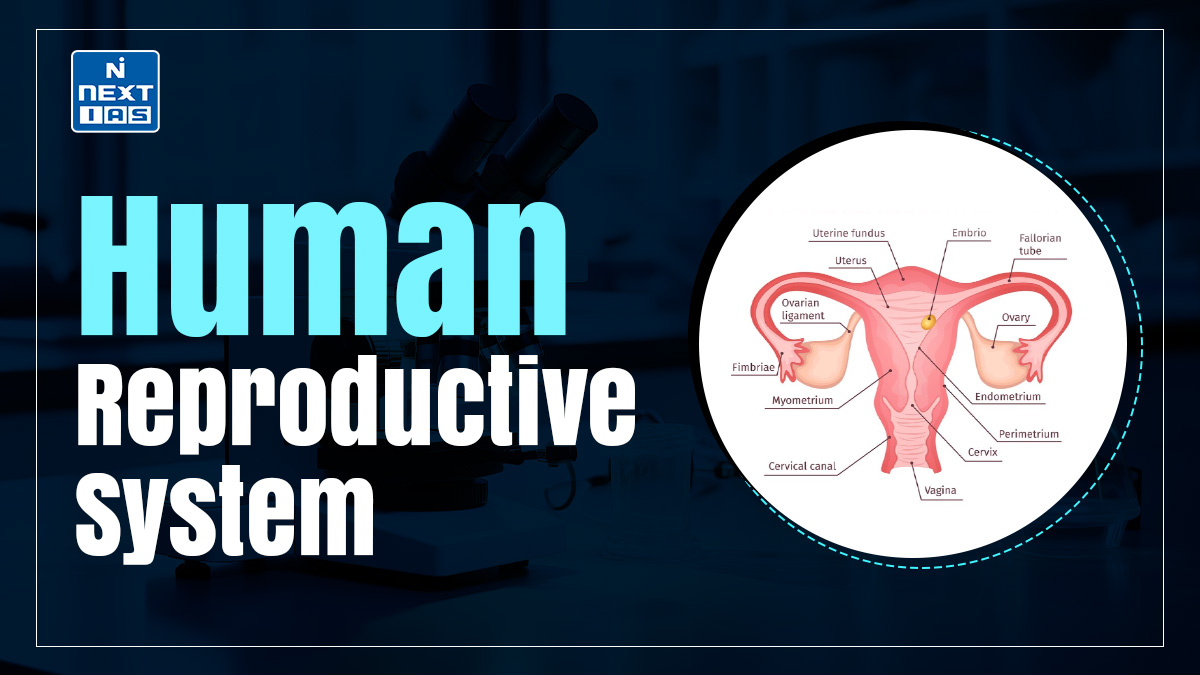
Nuclear power plants in India play a crucial role in meeting the nation’s energy demands sustainably. Operated by NPCIL (Nuclear Power Corporation of India Limited), these plants harness nuclear fission to generate electricity. India’s program focuses on indigenous reactors, global collaboration, and a three-stage strategy for energy security and self-reliance.
About The Nuclear Power Plants
- Nuclear power is the fourth-largest source of electricity in India after thermal, hydroelectric and renewable sources of electricity.
- India has 21 nuclear reactors in operation in 7 nuclear power plants, having an installed capacity of 5780 MW and producing a total of 30,292.91 GWh of electricity while 6 more reactors are under construction and are expected to generate an additional 4,300 MW.
- An ambitious plan to reach a nuclear power capacity of 63,000 MW in 2032.

| NUCLEAR POWER STATION | STATE | TOTAL CAPACITY (MW) |
|---|---|---|
| Tarapur | Maharashtra | 1,400 |
| Rawatbhata | Rajasthan | 1,180 |
| Kudankulam | Tamil Nadu | 2,000 |
| Kaiga | Karnataka | 880 |
| Kakrapar | Gujarat | 1140 |
| Kalpakkam | Tamil Nadu | 440 |
| Narora | Uttar Pradesh | 440 |
Planned Projects
| POWER STATION | OPERATOR | STATE | TOTAL CAPACITY (MW) |
|---|---|---|---|
| Jaitapur | National Power Corporation of India Limited | Maharashtra | 9,900 |
| Kovvada | National Power Corporation of India Limited | Andhra Pradesh | 6,600 |
| Mithi Virdi | National Power Corporation of India Limited | Gujarat | 6,000 |
| Haripur | National Power Corporation of India Limited | West Bengal | 4,000 |
| Kudankulam | National Power Corporation of India Limited | Tamil Nadu | 2,800 |
| Gorakhpur | National Power Corporation of India Limited | Haryana | 2,800 |
| Bhimpur | National Power Corporation of India Limited | Madhya Pradesh | 2,800 |
| Mahi Banswara | National Power Corporation of India Limited | Rajasthan | 1,400 |
| Kaiga | National Power Corporation of India Limited | Karnataka | 1,400 |
| Chutka | National Power Corporation of India Limited | Madhya Pradesh | 1,200 |
| Madras | Bharatiya Nabhikiya Vidyut Nigam Limited | Tamil Nadu | 300 |
Advantages of Nuclear Power Plants in India
- Low Carbon Emissions: Nuclear power produces minimal greenhouse gases, contributing to cleaner energy and combating climate change.
- Energy Efficiency: Nuclear reactors generate large amounts of energy from small amounts of fuel, ensuring efficient power generation.
- Energy Security: Reduces dependency on imported fossil fuels, enhancing energy independence.
- Base Load Power: Provides a stable and continuous power supply, unlike renewable sources like solar or wind.
- Long-term Cost Effectiveness: High initial costs are offset by low operating and fuel expenses over time.
- Supports Technological Advancement: Encourages research, innovation, and the development of advanced reactors like thorium-based systems.
- Employment Opportunities: Boosts job creation in construction, operation, and maintenance of plants.
- Utilization of Indigenous Resources: India leverages its thorium reserves, aligning with its three-stage nuclear program.
Recent Developments of Nuclear Power Plants in India
Recent developments in India’s nuclear power sector focus on advancing technology, increasing capacity, and sustainability:
- Bharat Small Reactors (BSR): India is developing these compact, modular reactors for flexible, cost-effective nuclear power generation. This marks a shift from traditional large-scale plants, with private sector partnerships driving innovation.
- Capacity Expansion: The government aims to triple nuclear energy capacity by 2032. Existing projects include six reactors under construction and new proposals for larger-scale reactors.
- International Collaboration: India is enhancing uranium imports and engaging in agreements with countries like France and Russia for reactor technology.
- Sustainability Goals: The 2024 Budget highlights research into low-emission energy technologies, including ultra-supercritical thermal plants, aligned with reducing greenhouse gas emissions.
These steps position India to meet growing energy demands while adhering to environmental commitments.
Challenges of Nuclear Power Plants in India
Nuclear power plants in India face several challenges:
- High Initial Costs: Construction and technology investments are expensive.
- Public Opposition: Safety concerns and environmental risks lead to resistance.
- Nuclear Fuel Supply: Dependence on uranium imports poses vulnerabilities.
- Waste Management: Handling radioactive waste safely is complex.
- Delays: Project execution often suffers delays due to policy and regulatory hurdles.
Nuclear Energy Parks
Kudankulam
- The Kudankulam Nuclear Power Plant (KNPP) is located 650 km south of Chennai, in the Tirunelveli district of Tamil Nadu, India. It is being developed by the Nuclear Power Corporation of India (NPCIL).
- Two 1,000MW pressurized water reactor (PWR) units based on Russian technology were erected in phase one of the project. An additional four units are scheduled to be added according to the agreement signed between India and Russia in December 2008.
- Atomstroyexport, a subsidiary of the Russian State Nuclear Energy Corporation Rosatom, is the supplier of equipment and fuels for the nuclear power project.
KNPP Reactor
- Kudankulam, or Koodankulam, is India’s first nuclear plant to use imported PWR technology. The existing nuclear power plants in India use pressurised heavy water reactor or boiling water reactor technology.
- KNPP uses the advanced version of Russian-developed PWR nuclear technology, VVER-1000 type reactors, also known as water-water power reactors. KNPP uses AES-92, also called the V-466 model, which is the latest version of the third-generation VVER-1000.
Safety Features
- The AES-92 includes a combination of active and passive safety solutions. It retains the traditional active safety provisions such as the use of neutron absorbing control rods to control the reactivity.
- The passive safety relies on natural factors such as pressure differentials, gravity or natural convection, to ensure protection against malfunctions during emergency situations.
- This include the fast injection of high-pressure boron and the provision of extra tanks for long-term supply of borated water to the reactor in a passive way, as well as a system for inter-containment area passive filtration.
- The reactor building has a series of passive hydrogen recombiners to convert abnormal production of hydrogen into water. This also includes a system for containing the molten-core of the reactor during severe accidents.
- AES-92 has a double protective containment with the inner envelope made of steel and the outer one made of heavy reinforced concrete steel. This prevents radioactive release into the environment during possible disasters, including earthquakes, tornadoes or aircraft crash. The inner containment is equipped with a water sprayer system to ease the steam pressure in the reactor.
Kudankulam Controversy
- The Kudankulam Nuclear Power Plant (KKNPP) was the outcome of an inter-governmental agreement between the erstwhile Soviet Union and India in 1988.
- During the period when KKNPP was first proposed, two other similar proposals were defeated following protests from local residents – one in Peringome near Kannur and another in Bhoothathankettu in Ernakulam district, both in the state of Kerala.
KKNPP Triggered India’s Largest Anti-nuclear Protests
Reasons for Protest
- Inspired by the ideals of German Greens and their leader Petra Kelly, a Green Party launched by Udayakumar in the early 2000s had eventually embraced the cause of Kudankulam villagers and their movements against KKNP.
- The KKNPP reactors are being set up without sharing the Environmental Impact Assessment (EIA), Site Evaluation Study and Safety Analysis Report with the people or the people’s representatives or the press. No public hearing had been conducted for the first two reactors either. There is absolutely no democratic decision-making in or public approval for this project.
- More than 1 million people live within the 30 km radius of the KKNPP which far exceeds the AERB (Atomic Energy Regulatory Board) stipulations. It is quite impossible to evacuate this many people quickly and efficiently in case of a nuclear disaster at Koodankulam.
- The coolant water and low-grade waste from the KKNPP are going to be dumped in to the sea which will have a severe impact on fish production and catch. This will undermine the fishing industry, push the fisherfolks into deeper poverty and misery and affect the food security of the entire southern Tamil Nadu and southern Kerala.
- The quality of construction and the pipe work and the overall integrity of the KKNPP structures have been called into question by the very workers and contractors who work there in Koodankulam. There have been international concerns about the design, structure and workings of the untested Russian-made VVER-1000 reactors.
Current Situation
- Unit 1 and Unit 2 of the Kudankulam NPP was put into commercial operation in 2014. The nominal capacity of Units 1 and 2 is 2000 MW.
- The tariff on Kudankulam NPP power generation is one of the most competitive tariff in India and the region. It is maintained at the level established by the Indian government back in 2010-2011 without any escalation. The cost of power generation from Kudankulam Nuclear Power Plant (KKNPP) is Rs 4.10 per unit.
Safety Analysis
- Kudankulam NPP is one of the safest in the world with all post-Fukushima safety requirements being implemented and functioning successfully.
- Active and passive safety systems ensure an unprecedented level of safety with the ability to prevent any anticipated operational occurrence. Among them are double localizing and protecting containment, passive heat removal system from reactor plant, core catcher, and closed industrial water intake for NPP.
Core Catcher: A core catcher is a device provided to catch the molten core material of a nuclear reactor in case of a nuclear meltdown and prevent it from escaping the containment building. India;s first is being installed at Unit 3 of Tamil Nadu’s Kudankulam Nuclear Power Plant (KKNPP).
Gorakhpur Haryana Anu Vidyut Pariyojana
- Gorakhpur Haryana Anu Vidyut Pariyojana (GHAVP) is situated in the Fatehabad district of Haryana State. It is proposed to have 4 x 700 MWe PHWR types of nuclear Power Plants at GHAVP Site.
Kovvada, Andhra Pradesh
- Kovvada Atomic Power Project is a proposed 6,600 MW nuclear power station in the state of Andhra Pradesh, India.
- The Kovvada project has been mired controversies right from its proposal stage about a decade ago. Fishermen and farmers off Kovvada area strongly resisted land acquisition plans by the state government and brought the works to a grinding halt.
Jaitapur, Maharashtra
- Jaitapur Nuclear Power Project (JNPP), first envisioned in 2009, kick-started with an agreement for two of six third-gen 1,650-MW European Pressurised Reactors (EPR), totalling 9,900 MW plus supply of nuclear fuel for 25 years. The deal was signed between Areva S.A. and the Nuclear Power Corporation of India Ltd. (NPCIL) in 2010.
- The leaders of France and India have reiterated their intention to start work by the end of 2017 on what could become the world’s largest nuclear power plant as Once installed, the Jaitapur project will be the largest nuclear power plant in the world, with a total capacity of 9.6 gigawatts.
Chhaya-Mithi Virdi, Gujarat
- The sites at Chhaya Mithi Virdi in Gujarat and Kovvada in Andhra Pradesh were accorded ‘In Principle’ approval and designated for setting up nuclear power plants in technical cooperation with the United States of America (USA).
Way Forward
- India’s nuclear power future emphasizes expanding capacity with indigenous and imported reactors, advancing thorium-based technology, and ensuring safety standards.
- Strengthening international collaborations, increasing public acceptance, and integrating renewable energy will support sustainable growth. Enhanced investment in research and infrastructure is vital for meeting rising energy demands and achieving net-zero goals.
Conclusion
Nuclear power plants are vital for India’s sustainable energy future, offering a clean and reliable power source. With advancements in technology, indigenous development, and international collaboration, India aims to expand nuclear energy’s share in its energy mix, contributing to economic growth, energy security, and efforts to combat climate change.
Frequently Asked Questions (FAQs)
How many nuclear power plants are there in India?
As of 2024, India has a total of 24 nuclear power reactors spread across several plants. The installed nuclear power capacity in India is 8,180 MW. Plans are underway to increase this capacity with 21 additional reactors currently under construction or in pre-project stages, aiming to reach a target of 22,480 MW by 2031-32.
Which is the largest nuclear power plant in India?
The largest nuclear power plant in India is the Kudankulam Nuclear Power Plant (KKNPP), located in Tamil Nadu. It has two VVER-1000 pressurized water reactors, each with a capacity of 1,000 MW, bringing the total installed capacity to 2,000 MW. Kudankulam is a joint project between India and Russia and plays a critical role in India’s nuclear energy sector.
Which state of India has no nuclear power plant?
As of now, the Indian state of Goa does not have a nuclear power plant. While other states like Tamil Nadu, Maharashtra, and Rajasthan host operational nuclear plants, Goa has no such facility. Goa’s energy needs are primarily met through other sources like natural gas, hydropower, and renewables.
Which is the largest operating nuclear power plant in India?
The Kudankulam Nuclear Power Plant (KKNPP), located in Tamil Nadu, is the largest operating nuclear power plant in India. With two VVER-1000 pressurized water reactors, each generating 1,000 MW, it has a total capacity of 2,000 MW. This plant is a joint venture between India and Russia and plays a crucial role in India’s nuclear power generation.
Which is India’s oldest nuclear power plant?
India’s oldest nuclear power plant is the Tarapur Atomic Power Station (TAPS), located in Maharashtra. It started operations in 1969 and consists of two Boiling Water Reactors (BWR) with a combined capacity of 320 MW. TAPS was the first nuclear power plant in India and remains a significant part of the country’s nuclear energy infrastructure.
What is India’s rank in nuclear power plants?
India currently operates 23 nuclear reactors across 7 nuclear power plants, contributing about 3% to its total electricity generation. The country ranks 8th globally in nuclear power generation. India is actively expanding its nuclear capacity, with plans to increase the total generation capacity by 70% by 2029, including the addition of 7 new reactors.






